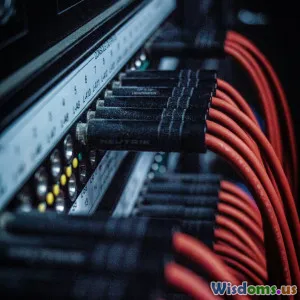
Why Most Home Firewalls Fail Against Modern Cyber Attacks
10 min read Explore why home firewalls often fail against modern cyber attacks and how to enhance your digital defenses effectively. (0 Reviews)
Why Most Home Firewalls Fail Against Modern Cyber Attacks
In an era when digital threats are evolving with unprecedented rapidity, the humble home firewall remains a critical, yet often flawed, bastion of defense. Every day, countless households rely on these lines-of-defense embedded in their routers or standalone devices to keep the storm of cyber attacks at bay. Yet, why do so many home firewalls fail to stop these insidious attacks? Why are home networks still compromised despite the promises of firewall protection?
This article takes a deep dive into the limitations of home firewalls, decoding the complexity of modern cyber threats and laying out why traditional firewalls often fall short. More importantly, it aims to empower readers with actionable insights and clearer understanding to bolster their home cybersecurity posture.
Understanding the Traditional Home Firewall: What Does It Do?
Before unraveling why most home firewalls fail, we must first understand what they are intended to do. Essentially, a home firewall acts as a barrier between a local home network and the wider internet, scrutinizing incoming and outgoing traffic based on predefined security rules.
Traditionally, firewalls prevent unauthorized remote access by blocking suspicious ports or IP addresses, filter known malicious traffic, and monitor packet flows to defend against common threats. They enforce access controls, providing a directional gatekeeper for network communication.
However, the functionality of many consumer-grade firewalls is limited mainly to basic port filtering, Network Address Translation (NAT), and simple packet inspection. While sufficient decades ago, the cyber threat landscape has dramatically transformed since then.
The Evolving Cyber Threat Landscape
Modern cyber threats have become polymorphic, targeted, and complex. According to a 2023 report from Cybersecurity Ventures, global cybercrime damages are projected to cost the world $10.5 trillion annually by 2025—a 15% increase over 2023.
These threats have evolved to exploit vulnerabilities that traditional firewalls aren’t designed to detect or mitigate:
- Advanced Persistent Threats (APTs): Attackers often stay hidden within networks for months or years, using legitimate credentials and encrypted tunnels beyond the reach of simple port-blocking firewalls.
- Encrypted Malware and Traffic: The increasing usage of HTTPS encrypts traffic, which masks malicious payloads from firewalls that lack Deep Packet Inspection (DPI). For instance, nearly 90% of the internet's traffic is encrypted, creating blind spots for conventional firewalls.
- IoT Device Vulnerabilities: The proliferation of Internet of Things devices introduces numerous entry points, often with default or weak security, bypassing firewall rules.
- Social Engineering & Phishing: Many attacks are user-triggered, leveraging phishing emails to install backdoors, which nullifies perimeter defenses.
The traditional firewall model stands inadequate against these dynamic and sophisticated threats that blend stealth, encryption, and social manipulation.
Why Most Home Firewalls Fail
1. Outdated and Limited Security Features
Many home firewalls embedded in routers rely on outdated firmware with limited ability to recognize or block emerging threats. Unlike enterprise solutions, consumer firewalls rarely incorporate advanced features such as Intrusion Detection Systems (IDS), Intrusion Prevention Systems (IPS), or real-time threat intelligence feeds.
2. Ineffectiveness Against Encrypted Traffic
Standard firewalls cannot inspect encrypted SSL/TLS traffic, which accounts for most of today’s internet exchanges. Sophisticated attackers hide their payloads within these encrypted streams, enabling malware and command-and-control traffic to slip through undetected.
3. Lack of Regular Updates and Maintenance
According to a 2022 survey by Comparitech, over 40% of users do not update their router firmware regularly. This leaves known vulnerabilities unpatched, providing hackers easy access. Even with a capable firewall, neglecting updates can expose users to compromises.
4. Misconfigured or Default Settings
Home users often leave firewalls configured with manufacturer defaults, which may allow unnecessary open ports or fail to block outbound malicious traffic. Default passwords or lax security parameters further undermine firewall effectiveness.
5. Insider and Device-Level Risks
Firewalls cannot control every device’s behavior inside the network. Compromised IoT gadgets, smartphones, or laptops can bypass firewall restrictions, communicate directly with attackers, or initiate harmful outbound connections.
Real-World Examples Demonstrating Firewall Failures
Case Study: 2018 Ring Camera Breach
In 2018, hackers exploited vulnerabilities in Ring's smart home cameras to spy on users. The home firewall failed to block attackers because the compromised devices were inside the network, and the breach happened through innocuous-seeming encrypted traffic.
IoT Botnets: Mirai and its Descendants
The Mirai botnet attack in 2016 and later variants involved hijacking poorly secured IoT devices on home networks—devices that firewalls did not or could not monitor effectively—launching massive DDoS attacks.
Colonial Pipeline Ransomware Attack (2021)
Although an industrial-scale incident, the Colonial Pipeline ransomware attack underscores how even robust firewalls without comprehensive cybersecurity hygiene and network segmentation leave systems vulnerable to social engineering and insider threats.
Enhancing Home Firewall Effectiveness: Best Practices
Though home firewalls face significant challenges, users can adopt several practices to fortify their defenses effectively.
1. Implement a Layered Security Approach
Don't rely solely on firewalls. Combine firewalls with endpoint security, antivirus software, and frequent patching. Layered security can compensate for weaknesses in one area with strengths in another.
2. Enable and Update Firmware Regularly
Regularly check your router or firewall vendor’s site for firmware updates. Some devices support auto-updating—enabling this feature is critical.
3. Use Firewalls With Advanced Features
Consider higher-end home routers or standalone firewalls that provide IDS/IPS capabilities, DPI, and real-time threat intelligence integration.
4. Manage IoT Devices Securely
Change default passwords, segment IoT devices on a separate network, and monitor their traffic for anomalies.
5. Configure Firewall Settings Proactively
Close unnecessary ports, disable remote administration unless needed, and customize settings to reduce open vulnerabilities.
6. Educate Household Members About Cyber Hygiene
Phishing remains a top attack vector. Training all users to recognize and avoid suspicious links and attachments can prevent attackers from bypassing firewalls.
7. Utilize VPNs and Encrypted DNS Services
While encryption challenges firewalls, using trusted VPN services and secure DNS can prevent data leaks and reduce exposure to phishing scams.
The Future of Home Firewall Security
Emerging technologies like AI-powered firewalls and home network security hubs promise to reshape how residential cybersecurity is managed. These solutions offer adaptive threat detection, behavioral analysis, and automated response—which are key to keeping pace with evolving cyber threats.
Furthermore, the push toward Zero Trust Architecture, even in home environments, advocates for continuous verification of devices and users rather than merely building a static perimeter.
For example, Google’s recent Nest Wifi Pro includes advanced threat protection that analyzes traffic patterns and blocks suspicious connections automatically. Services like Firewalla and Cujo AI provide home network monitoring with threat intelligence integration tailored for non-technical users.
Conclusion
Most home firewalls fail against modern cyber attacks because they rely on outdated methods, lack comprehensive traffic inspection, and suffer from user misconfiguration and neglect. The rapid sophistication in attacks leveraging encryption, insider access, and IoT device vulnerabilities overwhelms traditional defensive measures.
To counter this, a paradigm shift toward layered cybersecurity involving advanced firewalls, consistent updates, secure network segmentation, and user education is crucial. While no system is perfect, by understanding the limitations of standard home firewalls and actively adopting stronger practices, households can significantly reduce their exposure to cyber threats.
Remember, cybersecurity is not a one-time setup but an ongoing commitment—one that begins with knowing where traditional tools fall short and acting to build defenses that evolve alongside the threat landscape.
Stay vigilant, stay updated, and make your home network an unforgiving fortress for cyber attackers.
Rate the Post
User Reviews
Popular Posts


















